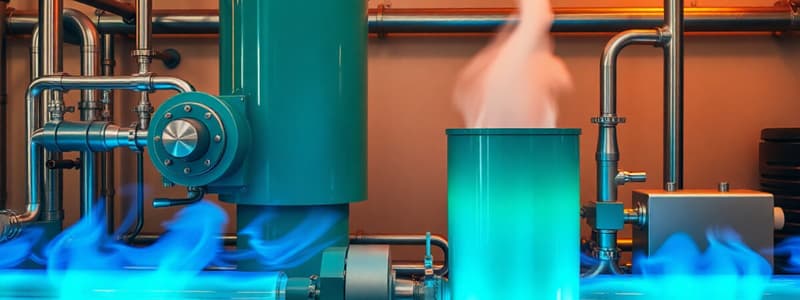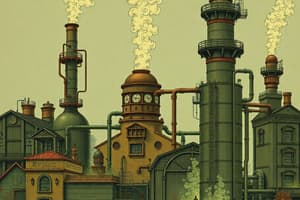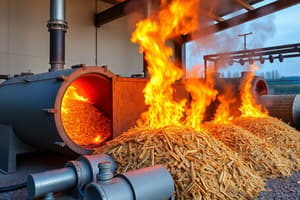Podcast
Questions and Answers
Which of the following is a key difference between biochemical and thermo-chemical methods of biomass conversion?
Which of the following is a key difference between biochemical and thermo-chemical methods of biomass conversion?
- Thermo-chemical methods require a slurry feedstock, while biochemical methods use solid biomass.
- Thermo-chemical conversion is more suitable for homogeneous feedstocks, biochemical is for heterogeneous.
- Biochemical methods produce syngas, while thermo-chemical methods produce biogas.
- Biochemical methods primarily involve anaerobic digestion, while thermo-chemical methods involve gasification. (correct)
Why does converting biomass into denser pellets improve energy efficiency compared to using raw firewood?
Why does converting biomass into denser pellets improve energy efficiency compared to using raw firewood?
- Pellets can be gasified more easily compared to raw firewood.
- Pellets have a higher carbon-to-hydrogen ratio, leading to more complete combustion.
- Pellets produce more ash, improving heat retention.
- Pellets have a significantly lower moisture content, leading to higher energy density. (correct)
Which of the following best explains the change in fuel characteristics achieved through gasification?
Which of the following best explains the change in fuel characteristics achieved through gasification?
- It decreases the heating value while increasing the carbon-to-hydrogen ratio.
- It adds non-combustible compounds to the fuel.
- It increases the heating value by removing non-combustible components. (correct)
- It converts high-value fuels into low-quality products.
What is the primary function of the oxidation zone within a gasifier?
What is the primary function of the oxidation zone within a gasifier?
In the context of gasification, what does the equivalence ratio represent, and why is it important?
In the context of gasification, what does the equivalence ratio represent, and why is it important?
How does the flow of the gasifying agent differentiate updraft, downdraft, and crossdraft fixed bed gasifiers?
How does the flow of the gasifying agent differentiate updraft, downdraft, and crossdraft fixed bed gasifiers?
What is a key operational difference between bubbling fluidized bed and circulating fluidized bed gasifiers?
What is a key operational difference between bubbling fluidized bed and circulating fluidized bed gasifiers?
Which of the following best describes the gas produced by an updraft gasifier, and why?
Which of the following best describes the gas produced by an updraft gasifier, and why?
Why are cross draft gasifiers not commonly used?
Why are cross draft gasifiers not commonly used?
How does the temperature within the oxidation zone of a down draft gasifier contribute to the gasification process?
How does the temperature within the oxidation zone of a down draft gasifier contribute to the gasification process?
What is the main advantage of using fluidized bed gasifiers compared to fixed bed gasifiers?
What is the main advantage of using fluidized bed gasifiers compared to fixed bed gasifiers?
Which of the following is a benefit of the lower operating temperatures in fluidized bed gasifiers?
Which of the following is a benefit of the lower operating temperatures in fluidized bed gasifiers?
How does gasification differ from combustion regarding the concentration of the resulting gases?
How does gasification differ from combustion regarding the concentration of the resulting gases?
What is a critical factor that limits the output capacity of gasification systems?
What is a critical factor that limits the output capacity of gasification systems?
During gasification and combustion, what happens to sulfur present in biomass, and how does it affect emissions?
During gasification and combustion, what happens to sulfur present in biomass, and how does it affect emissions?
Which equation represents the steam reforming reaction within a gasifier?
Which equation represents the steam reforming reaction within a gasifier?
What is the primary purpose of passing the exit gas through an annular jacket in a down draft gasifier?
What is the primary purpose of passing the exit gas through an annular jacket in a down draft gasifier?
Which of the following is a common operational issue faced by both fixed bed and entrained bed gasifiers?
Which of the following is a common operational issue faced by both fixed bed and entrained bed gasifiers?
What is the main reason that producer gas from an updraft gasifier contains tar and water vapor?
What is the main reason that producer gas from an updraft gasifier contains tar and water vapor?
During the gasification process, nitrogen exits without reacting, but can form NOx during combustion. Why is this the case?
During the gasification process, nitrogen exits without reacting, but can form NOx during combustion. Why is this the case?
Flashcards
What is Gasification?
What is Gasification?
A thermo-chemical conversion process that converts biomass into energy.
What is the Biochemical Method?
What is the Biochemical Method?
The anaerobic digestion of material to produce biogas, primarily CO2 and CH4.
What is the Thermo-chemical Method?
What is the Thermo-chemical Method?
The gasification of material in a gasifier to produce syngas, composed of CO, H2, CH4, CO2, and nitrogen.
What is Syngas?
What is Syngas?
Signup and view all the flashcards
What is the main purpose of gasification?
What is the main purpose of gasification?
Signup and view all the flashcards
What is the drying zone in a gasifier?
What is the drying zone in a gasifier?
Signup and view all the flashcards
What happens in the Pryolysis zone?
What happens in the Pryolysis zone?
Signup and view all the flashcards
What is the oxidation zone in a gasifier?
What is the oxidation zone in a gasifier?
Signup and view all the flashcards
What happens in the Reduction Zone?
What happens in the Reduction Zone?
Signup and view all the flashcards
What is the water gas shift reaction?
What is the water gas shift reaction?
Signup and view all the flashcards
What is Equivalence Ratio?
What is Equivalence Ratio?
Signup and view all the flashcards
Three main gasifier classifications
Three main gasifier classifications
Signup and view all the flashcards
Operational issues in entrained bed gasifiers
Operational issues in entrained bed gasifiers
Signup and view all the flashcards
Fixed bed gasifier types
Fixed bed gasifier types
Signup and view all the flashcards
How does a down draft gasifier work?
How does a down draft gasifier work?
Signup and view all the flashcards
How does a up draft gasifier work?
How does a up draft gasifier work?
Signup and view all the flashcards
Qualities of Fluidized bed gasifiers
Qualities of Fluidized bed gasifiers
Signup and view all the flashcards
Challenges of Circulating Fluidized Bed Gasifiers
Challenges of Circulating Fluidized Bed Gasifiers
Signup and view all the flashcards
How does combustion compare to gasification?
How does combustion compare to gasification?
Signup and view all the flashcards
Carbon products during gasification and combustion?
Carbon products during gasification and combustion?
Signup and view all the flashcards
Study Notes
Gasification Introduction
- Gasification is a thermo-chemical conversion process that converts biomass into energy.
- Using denser pellets made from biomass improves energy efficiency because of the lower moisture content (around 4-5%), unlike direct firewood use.
- Biomass can be converted into slurry for biogas production via anaerobic digestion.
- Alternatively, biomass can be gasified or incinerated to produce heat for steam generation.
- The focus is on gaseous fuel production from biomass, contrasting biochemical vs. thermo-chemical methods.
Biochemical vs. Thermo-chemical Methods
- The biochemical method involves anaerobic digestion of material to produce biogas.
- The thermo-chemical method primarily involves gasification of material in a gasifier to produce syngas.
- Both methods can be used for heterogeneous feedstocks like timber by-products, agricultural residues, forest raw materials, and household waste.
- Anaerobic digestion involves material being converted into slurry before digestion.
- Biogas mainly consists of CO2 and CH4, along with trace gases including H2S.
- Biogas's calorific value is approximately 20 MJ/m3.
- Biogas is suitable for cooking and street lighting, however engine applications require further processing.
- Thermo-chemical conversion produces syngas, composed of CO, H2, CH4, CO2, and nitrogen.
- Syngas's heating value is around 4-5 MJ/m3, and is a relatively clean gas.
- IC engines also need further processing of syngas before use.
Gasification Advantages
- Gasification offers flexibility with various biomass feedstocks, including MSW and materials with high moisture content.
- Thermo-chemical conversion efficiency of gasification can range from 70-90%.
- Output capacity is primarily limited by feedstock availability rather than technical considerations.
- Output gases are suitable fuels for internal combustion engines with capacities of about 15-30%.
- Gasification is a well-established technology dating back to 1830.
- Early applications used coal and peat to produce town gas for lighting and cooking.
- Around 1920 there was a shift where the produced gas was used to produce synthetic chemicals.
- During World War II, wood gas generators (gasogeneous) powered motor vehicles when petroleum was scarce.
- By 1945, heavy vehicles used gasification systems.
Motivations and Process Details
- Gasification converts potential fuel from one form to another.
- It increases the heating value of fuel.
- It does this by removing non-combustible compounds like water and nitrogen.
- Gasification reduces the carbon-to-hydrogen ratio.
- Biomass has higher oxygen relative to carbon than coal.
- This affects gasification since it is a partial oxidation process.
- Fuels with a high oxygen-to-carbon ratio have smaller heating value.
- Gasification turns these low-value fuels into high-quality products.
- Gasification involves converting solid or liquid feedstock into gaseous fuel via thermo-chemical method.
- It does this without leaving carbonaceous residue.
- It converts organic material at high temperatures in a controlled environment to gas.
- Primary stage, biomass is partially combusted forming producer gas and charcoal.
- Secondary stage, CO2 and H2O produced from the first stage is chemically reduced by the forming CO and H2.
- Producer gas composition is: 18-20% hydrogen, 19-21% carbon monoxide, 2-3% methane, 8-10% CO2, the rest is nitrogen.
- Gasifier design depends on the feedstock characteristics to maximize efficiency.
Gasifier Zones
- A gasifier is divided into a dry zone, pyrolysis zone, oxidation zone and reduction zone.
- Producer gas forms by partially combusting solid biomass in a vertical flow bed.
- The drying zone removes moisture from the incoming feed material.
- The pyrolysis zone converts feedstock into residual carbon (char).
- Combustible gases and tar are also produced from this zone.
- In the oxidation zone the oxygen in air/steam reduces carbon to hydrogen and carbon monoxide.
- Heat for pyrolysis and drying comes from partial combustion in the oxygen zone.
- The CO2 formed in the oxidation zone is reduced to carbon monoxide in the reduction zone.
- Producer gas composition depends on the water gas shift reaction, which reaches chemical equilibrium.
- Heat of combustion in the oxidation zone leads to the formation of non-combustible molten slag.
- Molten slag and ash are continuously removed through a seal slag tap into a water quench tank.
Reactions in Gasification
- Gasification involves both heterogeneous and homogeneous reactions.
- There are carbon, oxidation, shift, methanation and steam reforming reactions.
- Equations with "+Q" show heat absorbed.
- Equations with "-Q" shows heat released.
- Carbon reactions are C + CO2 -> 2CO, C + H2O -> CO + H2, C + 2H2 -> CH4.
- The oxidation reaction is C + O2 -> CO2
- The shift reaction is CO + H2O <-> CO2 + H2
- The methanation reaction is CO + 3H2 <-> CH4 + H2O
- The steam Reforming Reaction is CH4 + H2O <-> CO + 3H2
- The first 4 reactions are heterogeneous reaction where the carbon reacts with gases, including the oxidation reaction.
- Gaseous phase reactions are homogeneous gas phase reactions.
Equivalence Ratio
- Equilibrium composition of gaseous product depends on air supply relative to the amount of biomass.
- The equivalence ratio characterizes air supply conditions.
- Equivalence ratio is the ratio of air-to-fuel ratio (actual) to air-to-fuel ratio (stoichiometric).
- Stoichiometric amount is the exact amount of oxygen that is required to get the solid material gasified.
- For effective gasification, maintain an equivalence ratio of 0.2-0.4.
- If the ratio is <= 0.2, incomplete gasification occurs due to insufficient oxygen.
- This leads to more char and low calorific product gas, resulting in a pyrolysis dominant process.
- If the ratio is >= 0.4, combustion dominates due to excess oxygen.
- Excess oxygen leads to combustion with produced flue gas as a product.
Gasifier Classification
- Gasifiers are grouped as fixed bed, fluidized bed, and entrained bed.
- Grouping depends on how the gasifying agent and solid fuel interact.
- Fixed bed gasifiers are sub-classified as updraft, downdraft, and crossdraft.
- This is based on direction of the gasifying agent.
- Issues involved with the fixed bed gasifiers are slagging and bed agglomeration.
- Syngas exit blockage is another issue in the fixed bed gasifier.
- Slag mobility followed by the refractory degradation is another issue in the fixed bed gasifier.
- Forming molten slag result from the heat of combustion.
Gasifier Classifications and Operational Issues
- Molten slag produced in gasifiers can block the path of producer gas and degrade the refractory.
- Operational issues in gasifiers include slag mobility, refractory degradation, and syngas cooler fouling and plugging.
- Fluidized bed gasifiers are sub-classified into bubbling fluidized bed gasifiers and circulating fluidized bed gasifiers, based on gas velocity.
- Operational issues in fluidized bed gasifiers include bed agglomeration, defluidization, ash deposition, and fouling.
- Entrained bed gasifiers face operational issues like slag mobility, refractory degradation, and syngas cooler fouling and plugging.
Fixed Bed Gasifiers
- Fixed bed gasifiers are classified based on the flow of the gasifying medium: down draft, up draft, and cross draft.
- Up draft gasifiers are further subdivided into closed top and open top gasifiers.
- In down draft gasifiers, biomass is fed from the top, and the produced gas passes through a high-temperature zone to crack pyrolysis material.
- Down draft gasifiers produce a cleaner gas and are used in thermal and engine applications.
- Closed top down draft gasifiers are an older design requiring reasonably dry wood, while open top gasifiers are newer and can handle reasonably moist wood.
- Open top down draft gasifiers can achieve superior gas quality due to the gas passing through a high-temperature zone, cracking unburned pyrolysis material.
- In up draft gasifiers, biomass is fed from the top, and product gas is drawn off from the top, carrying tar and moisture.
- Up draft gasifiers produce high-tar gas with relatively high moisture content, despite potentially good gas quality.
- In cross draft gasifiers, oxidation occurs opposite the producer gas exit, resulting in poor gas quality and high tar content due to the short gas path.
- Cross draft gasifiers are not in common use.
Down Draft Gasifier Details
- Down draft gasifiers are divided into drying, pyrolysis, oxidation, and reduction zones.
- Gas produced is forced through a high-temperature zone, cracking unburned pyrolysis products.
- Drying zone temperature is around 350°C.
- Pyrolysis zone temperature ranges from 350 to 600°C.
- Oxidation zone temperature reaches 1000 to 1200°C, oxidizing pyrolysis products into CO, hydrogen, and CO2.
- Reduction zone temperature is 700 to 1000°C, reducing CO2 to carbon monoxide.
- Exit gas is passed through an annular jacket for efficient heat transfer and drying of incoming material, enhancing thermal efficiency.
- Down draft gasifiers suit various feedstocks, including MSW and high-moisture materials.
- Raw products pass through high-temperature zones, cracking unburned pyrolysis products into cleaner gas with more hydrocarbon content.
- In steady-state operation, combustion heat shifts to pyrolysis, losing 70-80% of weight.
- Pyrolysis products (CO, hydrogen, CO2, methane) oxidize in the oxidation zone to primarily CO and hydrogen.
- CO2 produced in the oxidation zone reduces to carbon monoxide in the reduction zone, resulting in relatively clean gas.
- Down draft gasifiers are also called concurrent moving bed gasifiers.
- Ash and slag are collected in a water quenching tank.
Up Draft Gasifier Details
- Up draft gasifiers are also called counter flow gasifiers.
- Biomass is fed from the top, and producer gas is drawn off from the top.
- Air enters at the combustion zone, and gas leaves from the top.
- Up draft gasifiers are easy to build and operate and achieve higher process efficiency because hot gas passes through the fuel bed and exits at a low temperature.
- The gas produced has practically no ash but contains tar and water vapor due to passing through unburned fuel.
- Up draft gasifiers are suitable for tar-free feedstock material and not for highly volatile material.
Cross Draft Gasifier Details
- Biomass enters from the top, with air entering through a water-cooled nozzle on one side of the firebox.
- Oxidation and reduction zones are confined next to the air nozzle.
- Short path length allows rapid response for changing gas production.
- High exit temperature and low CO2 reduction result in poor gas quality and low efficiency.
- These gasifiers are not in common use.
Fluidized Bed Gasifiers
- Fluidized bed gasifiers are versatile and can operate on any biomass form.
- They utilize excellent mixing characteristics and high reaction rates of gas-solid mixtures.
- A fluidized bed gasifier has a chamber with a bed of inner sand particles supported by a distributor plate.
- Air velocity is increased until the air drag supports the bed's weight, forming a fluidized bed.
- Turbulence is increased with velocity above the minimum utilization velocity.
- High surface area and constantly moving mass result in good conversion efficiency.
- Fluidized bed gasifiers operate at lower temperatures than fixed bed gasifiers and provide clean producer gas.
Circulating Fluidized Bed Gasifiers
- Circulating fluidized bed designs are compact and achieve high throughput.
- Inferior quality fuels can be gasified.
- A high energy conversion ratio results from intense gas-solid mixing and recirculation of unburned fuel, enhancing conversion efficiency.
- Less pollution (NOx, SOx, CO2) results from low-temperature operation.
- Challenges include complex gas-solid flow, maintaining pressure balance, solid circulation, solid movement through the loop seal, and maintaining uniform temperature.
- Fuel gas cleaning and ash disposal are also issues.
Bubbling Fluidized Bed Gasifiers
- These gasifiers achieve high throughput and can operate on any biomass material and tolerate reasonably high moisture material.
- Less pollution (NOx, SOx, CO2) is achieved due to low-temperature operation.
- Challenges include complex multiphase flow, chemical reactions, heat and mass transfer, precise control of operating parameters, unequal pressure distribution, hotspot, agglomeration, slagging, elutriation of solid fines, and loss of unburned fuel particles.
Advantages of Fluidized Bed Gasifiers
- Fuel flexibility allows using oils with calorific values of 800 to 8000 kcal/kg.
- Good heat storage ensures combustion.
- Quick startup and high combustion efficiency are advantageous.
- Fluidized bed gasifiers have high output rates and consistent combustion due to uniform distribution of solids and gasifying medium.
- Fuels with high moisture content can be used.
- Rapid response to fuel input changes is another benefit.
- Low-temperature operation reduces corrosion from alkali compounds in ash.
- Uniform temperature provides high process efficiency and reduced nitrous oxide emissions.
- Sulphur dioxide emission can be reduced to acceptable levels with less expense.
Comparison of Gasification and Combustion
- Combustion produces more flue gas than gasification.
- Gasification results in higher concentrations of produce gas, while combustion leads to lower concentrations of produce gas.
- SO2 emissions are higher in combustion compared to gasification.
- NOx emissions are higher in combustion due to higher temperatures.
- Solid waste generation is higher in combustion.
- Transportation of combustion products is difficult, while gasified products are easy to transport.
- Combustion products have limited value-added potential, while gasified products can be further processed into valuable chemicals.
- Combustion has a narrow application range, mainly as a heat source or steam production.
- Gasification has a wide application range, including use as a heat source and in IC engines, and conversion into valuable chemicals.
- Carbon dioxide production in the gasification process is relatively lower than in combustion.
- During combustion and gasification, the carbon in solid fuel becomes CO during gasification and CO2 during combustion.
- Hydrogen converts to H2O due to complete oxidation during combustion.
- Hydrogen is reduced to H2 in gasification.
- Nitrogen exits without reacting but can form NOx during combustion.
- Sulphur, if present in biomass, forms H2S during gasification.
- Sulphur forms SOx because of complete oxidation of the sulphur compound in the biomass if any, during combustion.
- Excess oxygen exits the combustion chamber.
- Gasification occurs with a limited oxygen supply, so unused oxygen doesn't exit.
- The composition of gaseous products differs between combustion and gasification.
- The next lecture will cover pyrolysis and chemical conversion processes.
Studying That Suits You
Use AI to generate personalized quizzes and flashcards to suit your learning preferences.




